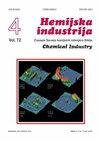The use of salicylaldehyde derivatives as a nitrogen source for antibiotic production by Streptomyces hygroscopicus CH-7
IF 0.8
4区 工程技术
Q4 ENGINEERING, CHEMICAL
引用次数: 1
Abstract
In the present work, four derivatives of salicylaldehyde (salicylaldehyde-hydrazone, phenylhydrazone, semicarbazone and thiosemicarbazone) were synthesized using both conventional (95% ethanol) and green (crude glycerol from biodiesel production) solvents. The obtained compounds were identified by elemental microanalysis, as well as FTIR, UV/VIS, 1H NMR and X-ray spectroscopic methods. Yields of 93-98% of the compounds in crude glycerol were achieved within 10-25 min. The derivatives of salicylaldehyde and crude glycerol were used as a nitrogen and carbon source, respectively, in the medium for antibiotic (Hexaene H-85 and Azalomycine B) production by Streptomyces hygroscopicus CH-7. The highest concentrations of Hexaene H-85 and Azalomycine B were achieved in the medium containing salicylaldehyde-thiosemicarbazone (198 g/cm3 and 69 µg/cm3, respectively). Derivatives of salicylaldehyde also impacted the strain morphology. In the media with salicylaldehyde-phenylhydrazone and salicylaldehyde-thiosemicarbazone, S. hygroscopicus CH-7 grew like large dispersive pellets with long twisted filaments that produced the highest yield of the antibiotics.吸湿链霉菌CH-7利用水杨醛衍生物作为氮源生产抗生素
采用常规溶剂(95%乙醇)和绿色溶剂(生物柴油生产的粗甘油)合成了水杨醛的四种衍生物(水杨醛腙、苯基腙、氨基脲和硫代氨基脲)。通过元素微量分析、FTIR、UV/VIS、1H NMR和x射线光谱等方法对所得化合物进行了鉴定。在10-25 min的时间内,粗甘油中93% -98%的化合物的产率都达到了。在吸湿链霉菌CH-7生产抗生素(Hexaene H-85和Azalomycine B)的培养基中,水杨醛和粗甘油的衍生物分别作为氮源和碳源。在含有水杨醛-硫代氨基脲的培养基中,六烯H-85和氮唑霉素B的浓度最高(分别为198g/cm3和69µg/cm3)。水杨醛衍生物对菌株形态也有影响。在含有水杨醛-苯腙和水杨醛-硫代氨基脲的培养基中,吸湿葡萄球菌CH-7生长成具有长扭曲丝的大分散颗粒,抗生素产量最高。
本文章由计算机程序翻译,如有差异,请以英文原文为准。
求助全文
约1分钟内获得全文
求助全文
来源期刊

Hemijska Industrija
工程技术-工程:化工
CiteScore
1.60
自引率
11.10%
发文量
12
审稿时长
6-12 weeks
期刊介绍:
The Journal Hemijska industrija (abbreviation Hem. Ind.) is publishing papers in the field of Chemical Engineering (Transport phenomena; Process Modeling, Simulation and Optimization; Thermodynamics; Separation Processes; Reactor Engineering; Electrochemical Engineering; Petrochemical Engineering), Biochemical Engineering (Bioreactors; Protein Engineering; Kinetics of Bioprocesses), Engineering of Materials (Polymers; Metal materials; Non-metal materials; Biomaterials), Environmental Engineeringand Applied Chemistry. The journal is published bimonthly by the Association of Chemical Engineers of Serbia (a member of EFCE - European Federation of Chemical Engineering). In addition to professional articles of importance to industry, scientific research papers are published, not only from our country but from all over the world. It also contains topics such as business news, science and technology news, information on new apparatus and equipment, and articles on environmental protection.
 求助内容:
求助内容: 应助结果提醒方式:
应助结果提醒方式:


